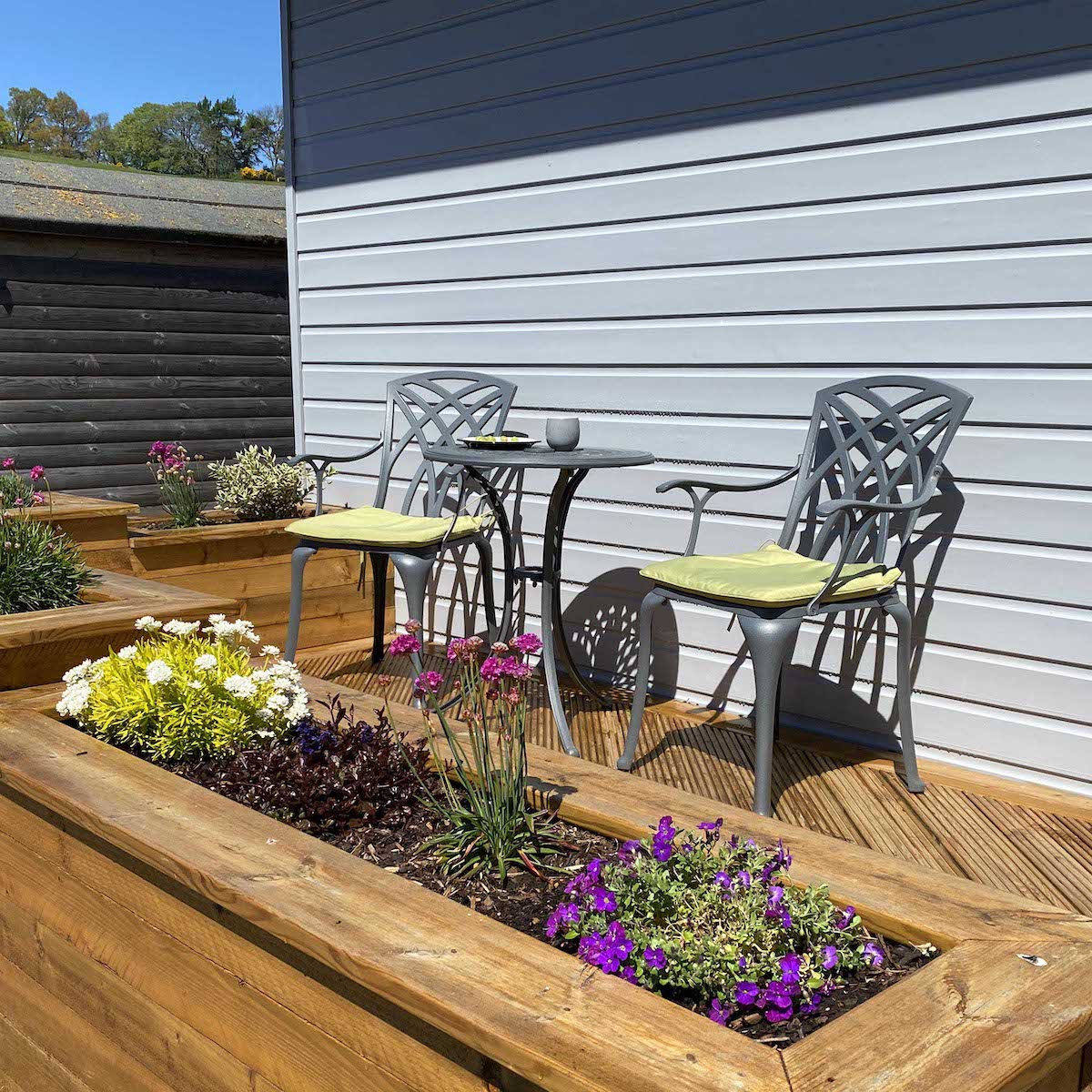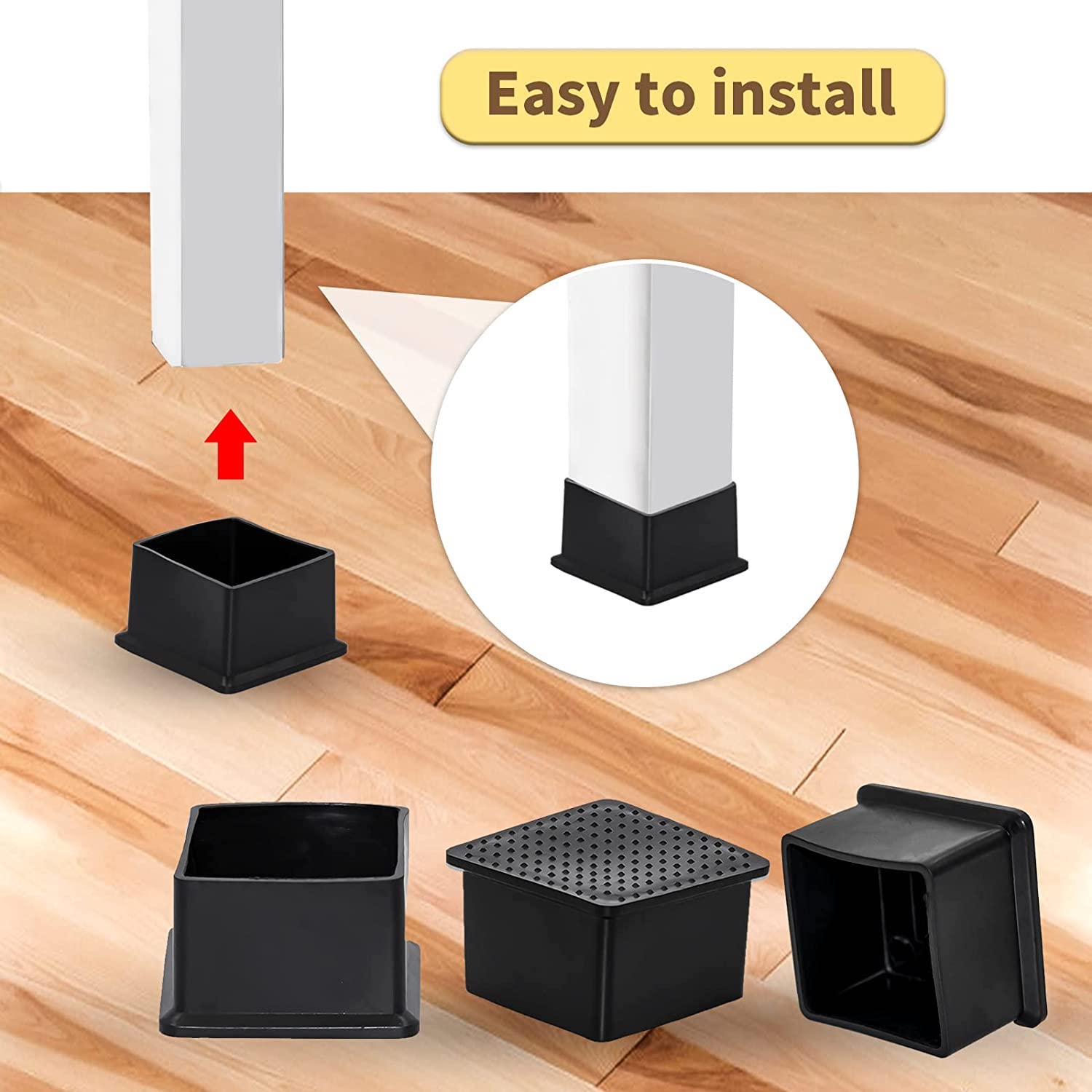Our recent can you put metal garden furniture on a stone patio article was in response to a number of e-mails we’d received from customers who were concerned about stone chips.
However, let us assure you, there is no cause for concern as our garden tables and chairs are supplied with screw-in plastic foot pads (see below) that protect the furniture itself and the deck or patio, plus, they are adjustable for any uneven surfaces.

In response to the why stone patios won't chip our furniture post, we received a comment looking at it from the other side of the coin.
A customer is getting a new composite deck installed in the spring and wanted to check if her Lazy Susan garden furniture could scratch the decking boards?
It is a very good question and one we're happy to dive in a take a closer look...

Both real wood and composite decking are beautiful to look at but expensive to install, but let us again assure you, there is no cause for alarm.
Our metal garden furniture, with a little caution, will not damage wood or composite decking!
But for peace of mind, let's expolore the reasons why. Plus, we've got a few simple tips and tricks to help keep your decking protected from garden furniture if you are concerned.
What is the difference between wood and composite decking?
Of course, we all know what decking is and we all know what wood is, but composite lumber and decking is the new kid on the block, so a bit of clarification and a brief explanation is helpful.
Wikipedia defines composite lumber as:
“Composite lumber is a material that is a mixture of wood fibre, plastic, and some type of binding agent. These ingredients are put together to form a material that is denser, stronger, and heavier than wood alone, a wood-plastic composite.”
A traditional wooden deck is commonly made from a pressure-treated softwood that is industrially "injected" with a wood preservative (approved under UK Government regulations) to provide a material that is fit for purpose.

Composite decking and its mix of wood fibres and recycled plastic are designed to give your garden the look and feel of real wood decking, whilst removing the drawbacks associated with wood such as high maintenance.
While it tends to cost more than real wood, composite lumber will provide greater durability and remove the need to sand and stain.
Wood is still the most common choice in the UK for decking but it doesn't last forever, while composites on the other hand lack the natural look and feel of the real thing.

There is also a third option now on sale in the UK and that is uPVC decking. Whilst composite decking is designed to absorb less moisture than real wood, UPVc takes this a step further and will absorb no moisture.
The uPVC decking sold in the UK is constructed from a sustainable thermoplastic too, so it can be re-melted and recycled.
Why our metal garden furniture won’t scratch your decking
The advantage wood has over composite and uPVC decking is that it can be easily repaired. If you were to say damage it by dragging a garden chair, then it can be easily filled, sanded and re-stained.

Composite and uPVC, whilst pretty tough, can be scratched and repairing is a little more complicated (although you could replace a plank or two if need be).
Garden tables and chairs with metal feet or legs are particularly prone to creating scratches or marks on decking. Garden furniture often needs to be moved, so it pays to be careful, and pick up garden chairs rather than drag them.

As mentioned in the intro, we supply our garden tables and chairs with screw-in plastic pads (shown in the photo above), and the reason for this is threefold:
- To prevent our metal furniture from scratching decking.
- To prevent the patio surface (especially stone) from chipping the protective painted finish on our metal furniture.
- To provide a little adjustment for uneven surfaces.
The plastic pad is designed to smoothly glide over your decking and prevent it from scratching. That’s not to say it won’t scratch, caution is needed, and as the saying goes, “prevention is better than cure”.
How to prevent scratches on your decking from garden furniture

There are a number of things you can do to minimise the risk of scratching all types of decking, be it wood, composite or uPVC, and these are the Lazy Susan team's top 5 solutions:
1. Keep your deck clean and well maintained

Probably the best way to protect your decking from scratches, in general, is to keep it clean and well-maintained. No matter if wood or composite, keeping it free of debris such as twigs and stones is essential as they can get caught underfoot or furniture.
If you have a timber deck then maintenance is most critical to keeping it in good condition. Keep it clean and seal it with specialist treatments to not only prevent scuffs and scratches but to best protect it from the elements and reduce the likelihood of warping or splitting.
2. Lift don’t drag your garden furniture on your decking

We mentioned this above but it is worth repeating that if you need to move your garden furniture, be it a garden chair you’re pulling out to sit on or a larger piece such as a sofa that you need to move to sweep up, try and lift rather than drag.
This applies not just to furniture, but outdoor storage boxes, garden toys, BBQs, etc too. And this links more to point one, often the item won’t scratch the deck, however, grit or stones that find their way onto your decking could get trapped underneath them and do some damage.
3. Add felt to the feet pads of our garden chairs and tables

If you have Lazy Susan garden furniture and you’re still a little concerned about the plastic feet pads on the surface of your wood or composite decking, then a great hack is to apply some waterproof felt feet pads.
Adsamm® sell a comprehensive range on Amazon, that's a great low-cost solution and the adhesive is strong so we’ve found they stay on pretty well when used outdoors. They do come off over time but their 20 mm rubber pad is a neat fit and they come in a pack of 50 (pictured above).
4. Use feet cups on your garden furniture to protect your deck

If you have garden furniture for another supplier without feet pads like ours or a different style, then for us the best solution is a rubber style feet cup.
This is a case of shopping around on the likes of Amazon and eBay for the best solution in terms of shape and size as the choice is a wide one. If for example, you have a square wooden set, then the Flyshop Furniture Caps (above) would be a great option. Alternatively, something with a round leg, then TARIO's Silicone Cups (below) would fit better.
![]()
5. Place an outdoor rug on your deck

Outdoor rugs are not only on trend and super stylish but they also provide excellent protection to the surface of your deck. They are made from fabrics that are designed to withstand lots of traffic and exposure to the elements without staining or encouraging mould growth.
A good outdoor rug will protect your timber or composite deck in high-traffic areas such as the seating zone and protect the boards from scratches and scraping from frequently moved garden chair legs.
If you have any tips or products you’ve used to prevent metal garden furniture from damaging wood and composite decking then please share them by dropping a comment below.
If you have any photos of your Lazy Susan Metal Garden Furniture on your decking or patio, then we’d love to see a few snaps for our Do Some Good charity campaign. You can tag us @LazySusanFurniture on Instagram or Facebook or email them to us at [email protected].



